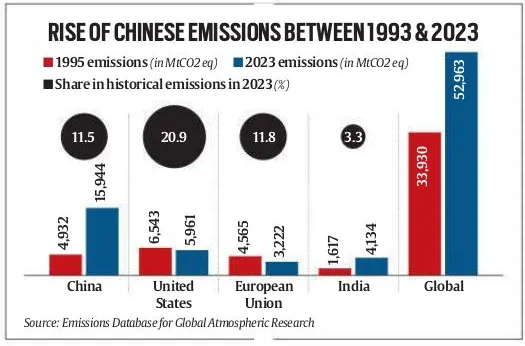Table of Contents
China’s Domination and Current Status

- Global Emissions Leader: China contributes over 30% of global annual emissions.
- It remains the world’s largest emitter for over 15 years.
- Its emissions are now 3 times that of the United States.
- Renewable Energy Manufacturing Hub: China controls:
- >80% of global solar panel manufacturing, dominating every step of production.
- ~60% of global wind turbine production.
- Large shares in batteries, hydrogen electrolysers, and critical minerals required for clean energy.
- Economic Leverage: Solar panel manufacturing costs in China are 10% lower than India, 20% lower than the US, and 35% lower than Europe.
- Renewable Energy Deployment: Added 300 GW of renewable energy capacity in 2023, expected to reach 1,200 GW by 2024, 6 years ahead of schedule.
The Need for Chinese Emission Cuts
- Analysis by Climate Action Tracker (CAT): It indicates that China needs to reduce its emissions by 66% by 2030 and 78% by 2035 to align with the 1.5-degree Celsius target set by the Paris Agreement.
- However, such deep cuts are deemed unrealistic in the near term due to China’s ongoing economic recovery and energy-intensive growth patterns.
- NDC Ratings: China’s Nationally Determined Contributions (NDCs) are rated as “highly insufficient,” indicating that current policies do not align with the goals necessary to limit global warming.
Challenges and Paradoxes
- Dependence on Fossil Fuels: Renewable energy is expanding capacity but not replacing fossil fuels.
- g., renewables only make up a single-digit percentage of its primary energy supply, and coal generates over 50% of its electricity.
- Impact of Emission Cuts on Global Supply Chains: The production of renewable energy equipment like solar panels and wind turbines heavily relies on fossil fuels.
- If China makes deep emission cuts:
- It could slow the deployment of renewable energy equipment globally, impacting energy transitions worldwide.
- This would jeopardise the goal to triple renewable energy capacity by 2030.
- Differentiated Responsibilities Under Climate Agreements: As a “developing” country under the UN climate framework, China is not mandated to make immediate, deep emission cuts. This limits global pressure.
- If China makes deep emission cuts:
Way Forward
- Diversification of Global Supply Chains: Other countries should invest in renewable manufacturing to reduce over-dependence on China.
- Gradual Transition from Fossil Fuels: Implement phased coal reduction plans while scaling up renewable integration to ensure a stable energy supply.
- International Collaboration on Technology: Facilitate partnerships for cost-competitive production of renewable equipment outside China, especially in regions like India, Europe, and the US.
- Balanced Emission Reduction Plans: Encourage China to adopt incremental emissions reduction targets without jeopardising global renewable production.
- Innovation in Low-Carbon Manufacturing: Invest in research to reduce the carbon footprint of renewable energy equipment manufacturing.
- Policy Incentives for Green Energy: Global frameworks must incentivize China to accelerate clean energy transitions through financial and technological support.


 Utkal Divas 2025: Odisha Foundation Day ...
Utkal Divas 2025: Odisha Foundation Day ...
 List of Military Exercises of India 2024...
List of Military Exercises of India 2024...
 Africa’s Nuclear Energy Market Status ...
Africa’s Nuclear Energy Market Status ...





















